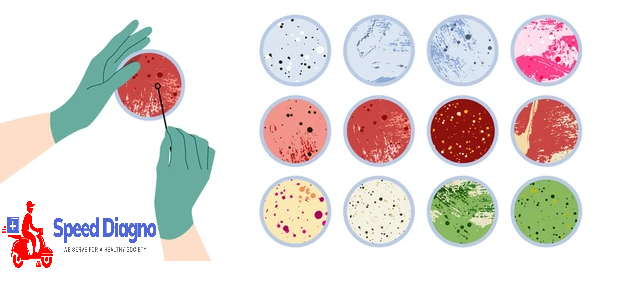- Home
-
Test Categories
- Diabetes
- Urinary
- Thyroid
- RTPCR
- Genetic
- Cancer
- Haematology
- Biochemistry
- Serology & Immunology
- Clinical Pathology
- Cytology
- Microbiology
- Endocrinology
- Histopathology
- MOLECULAR DIAGNOSTICS
- Pregnancy(Biochemistry)
- Liver
- Prostate
- Fertility
- Gastro
- Autoimmune Disorders
- Heart
- Kidney
- Vitamins
- Tuberculosis (TB)
- Anemia
- Fever
- Allergy
- Blood Tests Rare
- Profiles
- Packages
- About Us
- Why Choose Us
- Upload Prescription
- Corporate Wellness
- Contact Us

-
Overview
Blood Culture and Sensitivity is a diagnostic test used to detect the presence of bacteria or fungi in the blood, which can indicate severe infections such as septicemia or bloodstream infections. The test involves taking a blood sample and culturing it in a laboratory to identify any microorganisms present. Sensitivity testing determines which antibiotics or antifungal medications are most effective in treating the identified pathogens. This test is crucial for guiding the appropriate treatment of serious infections, especially in hospitalized or critically ill patients.
Patient Preparation for Blood Culture and Sensitivity
Fasting Requirements:
- Fasting: No fasting is required for this test. However, it is important that the blood sample is collected when the patient is exhibiting symptoms such as fever or chills, as this increases the likelihood of detecting the pathogen.
Other Preparations:
- Avoid Antibiotics: If possible, blood cultures should be collected before starting antibiotics. If the patient is already on antibiotics, this should be communicated to the healthcare provider as it may affect the results.
- Hydration: Patients are advised to stay well-hydrated to facilitate easier blood draw.
Blood Sample Collection by Speediagno Phlebotomist:
Speediagno phlebotomists follow strict protocols to ensure safe, accurate, and contamination-free blood collection for culture and sensitivity testing.
Preparation for Blood Collection:
- Identify the Patient: The phlebotomist confirms the patient’s identity using at least two identifiers (e.g., name and date of birth).
- Consent and Explanation: The procedure is explained to the patient, and consent is obtained to ensure the patient is comfortable with the process.
Blood Collection Process:
- Hand Hygiene and PPE: The phlebotomist performs hand hygiene and wears appropriate Personal Protective Equipment (PPE) such as gloves, masks, and gowns to prevent contamination.
- Prepare Equipment: All necessary materials, including sterile needles, blood culture bottles (aerobic and anaerobic), antiseptic swabs, and gauze, are prepared.
- Patient Positioning: The patient is seated comfortably, and the phlebotomist selects a suitable vein, usually in the antecubital fossa (inner elbow).
- Antiseptic Preparation: The selected venipuncture site is cleaned with an antiseptic solution (such as chlorhexidine or iodine) to thoroughly disinfect the area and prevent contamination of the sample.
- Blood Collection:
- A sterile needle is used to draw blood directly into blood culture bottles, typically drawing samples for both aerobic and anaerobic cultures.
- Care is taken to avoid touching the needle or bottle tops to prevent contamination.
- The volume of blood collected is crucial, often 10-20 mL per bottle, as an adequate sample size increases the likelihood of detecting pathogens.
- Mixing and Labeling: The bottles are gently mixed if required and labeled accurately with the patient's information, including date and time of collection.
Post-Collection Care:
- Pressure and Bandage: After removing the needle, pressure is applied to the puncture site, followed by a bandage to prevent bleeding.
- Patient Instructions: The patient is advised to avoid strenuous activities with the arm used for blood draw and to report any unusual symptoms.
- Sample Handling and Transport: The blood culture bottles are transported to the laboratory promptly and under proper conditions to prevent temperature fluctuations that could affect bacterial growth.
Safety and Hygiene Protocols:
- Disposal of Sharps: Used needles and other sharp objects are disposed of in designated sharps containers.
- Documentation: Proper documentation of the procedure, including details of the sample collection time, is completed to ensure traceability and accurate processing.
This meticulous and professional approach to blood culture and sensitivity testing ensures that the sample collected is of high quality, free from contamination, and processed correctly to provide valuable information for diagnosing and treating bloodstream infections.
All test groups and subgroup
-
BLOOD CULTURE AND SENSITIVITY
- Sample
- Gram Staining
- Organisums Isolated
- Colony Count
- REPORT
- Note
- Sensitivity pattern
- Amikacin
- Agumentin(Amoxicillin-clavulanic acid)
- Ampicillin
- Cefpoparazone
- Cefotaxime
- Cefuroxime
- Ceftazidime
- Ceftizoxime
- Ceftriaxone
- Co-trimoxazole
- Gentamycin
- Netilmycin
- Cefazolin
- Cefdinir
- Ciprofloxacin
- Azithromycin
- Linezolid
- Oxacillin
- Tetracycline
- Vancomycin
- Tiecoplanin
- Doxycycline
- Moxifloxacin
- Cefpodaxime
- Cefuroxime
- Chloramphenicol
- Colistin
- Imipenam
- Levofloxacin
- Ofloxacin
- Pipercillin
- Pipercillin & Tazobactum
- Tobramycin
- Meropenam
- Carbenicillin
